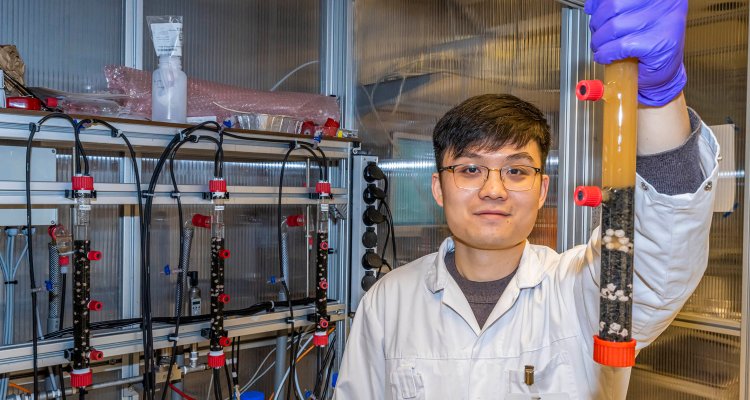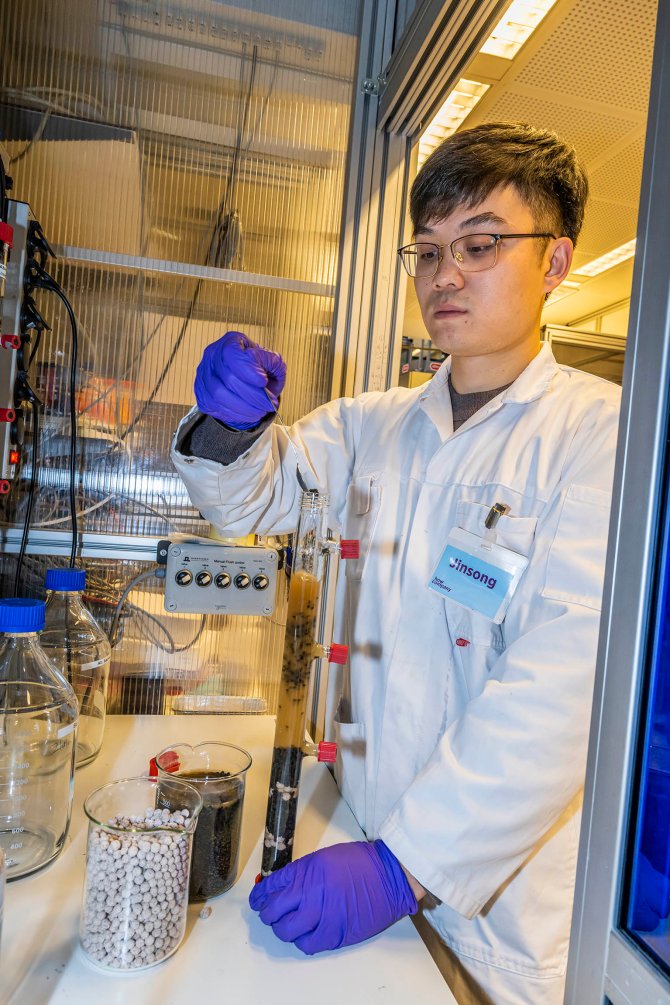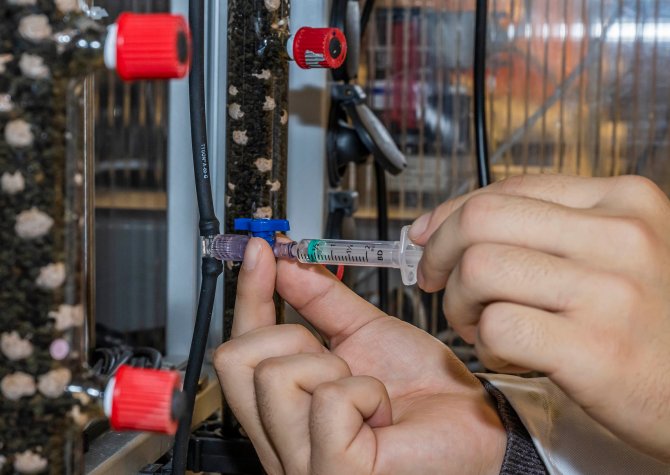
News
Science: Biological degradation of micropollutants using rapid sand filters
By modifying the sand filtration process, used by drinking water companies for water purification, ETE PhD scientist Jinsong Wang improved the removal of the so-called micropollutants. By adapting the operational conditions in the sand filter, like flow rate and available nutrients, he increased the biological degradation of these contaminants. To further develop this drinking water purification method, he is currently focusing on specialized bacteria that are able to efficiently degrade selected micropollutants.
Micropollutants are relatively new, emerging contaminants that include residual medicines, pesticides, and industrial chemicals. These chemicals are difficult to remove from water and this has resulted in more pollutant discharge in drinking water sources during the last decade. Due to improved analytical methods, the presence of these compounds in water has been shown. Many of these micropollutants may cause health effects in humans and animals. For example, they may promote cancer and disrupt the hormonal system.

Increased input
Pharmaceuticals are micropollutants of big concern, but also pesticides used in agriculture may end up in the environment, contaminating rivers and ground water. Today, even pristine ground water sources used for drinking water have already become contaminated with these compounds. In the future, micropollutants are expected to increase in drinking water sources. This inevitably will result in an increased input into produced drinking water. It is therefore crucial to develop more effective methods for efficient removal of these contaminants from drinking water.
Existing technology
Drinking water companies use microorganisms to biologically clean surface and ground water using, among others, rapid sand filtration. However, these sand filters are rather ineffective to remove some of the micropollutants. As a result, these substances remain in the water and eventually end up at the consumer. To ensure clean and safe drinking water, existing water purification methods need to be improved. Since sand filtration is a commonly used biological cleaning technology at drinking water companies, Wang’s research is aimed at adapting this existing technology to enhance micropollutant degradation. This adaptation focuses on modifying the microbial degradation processes inside the sand filtration column. ‘We aim to stimulate the growth of specific microorganisms that are capable of degrading micropollutants’, Wang explains. ‘First, we select different microbial communities and test their abilities to degrade micropollutants. In a next step, we supply different nutrients to boost their growth and subsequently check if there is an increased degradation of micropollutants.’ Wang’s first experiments showed very promising results: using a simple bottle in his experiments, a so-called ‘batch reactor’, Wang showed that by adding ammonia and methane, nutrients for nitrifying and methanotrophic bacteria, these microorganisms proliferated and were able to degrade and remove 30-40 percent of the pesticide bentazone present in the test samples, while they almost completely broke down caffeine.
Case-specific operational conditions
To perform his studies in a more realistic way, Wang moved his experiments from a batch reactor, to a column reactor. In this set-up, a continuous flow through a sand bed containing different bacteria, better matched the purification conditions in the sand filtration technology as used by drinking water companies. Wang: ‘The main aim of these experiments was to study how the operational conditions, like flow rate and bacterial food sources, like ammonium and organic carbon concentrations, affected the micro- pollutant degradation.’ The results from the first experiments were somewhat unclear. Adding more nutrients, like organic carbon, resulted in some cases in a better micropollutant removal, for example for paracetamol. However, benzotriazole, a compound used in the chemical industry, showed a lower removal rate by adding more organic carbon. ‘I think that the benzotriazole-degrading bacteria prefer just less carbon nutrients for biodegradation, so there is an over-feeding of carbon, resulting in a lower benzotriazole removal’, Wang explains. ‘That means that depending on the micropollutant present we need to adapt case-specific operational conditions, in this case the amount of nutrients added, for an optimal contaminant removal.’

Technical optimization
Until recently Wang focused his research on native bacteria, that were naturally present in the sand filter. However, for an even better micropollutant removal, he is currently studying the effect of adding commercially available bacterial strains that are able to degrade specific micropollutants. For example, some strains can degrade the commonly used herbicides 2,4-Dichlorophenoxyacetic acid (2,4-D) and mecoprop (MCPP). Using these commercial strains has some challenges though. ‘Since micropollutants are at such low concentrations, the bacteria might not get enough nutrients and consequently die due to starvation’, Wang says. ‘Also, these bacteria are not as well attached to the sand particles and might be flushed out due to the relatively fast flow rate through the column.’ To prevent this, Wang adds extra organic carbon to boost bacterial growth, in addition to porous quartz stones, that shield the bacteria from the flow, so they can grow in a protected environment.’ Within a few years, Wang hopes that his research will contribute to using sand filters for a more efficient removal of a variety of different micropollutants for cleaner and safe drinking water.
Selected publication:
Wang, J., de Ridder, D., van der Wal, A., Sutton, N.B., 2021. Harnessing biodegradation potential of rapid sand filtration for organic micropollutant removal from drinking water: a review. Crit. Rev. Environ. Sci. Technol. 51 (18), 2086–2118.https://doi.org/10.1080/10643389.2020.1771888